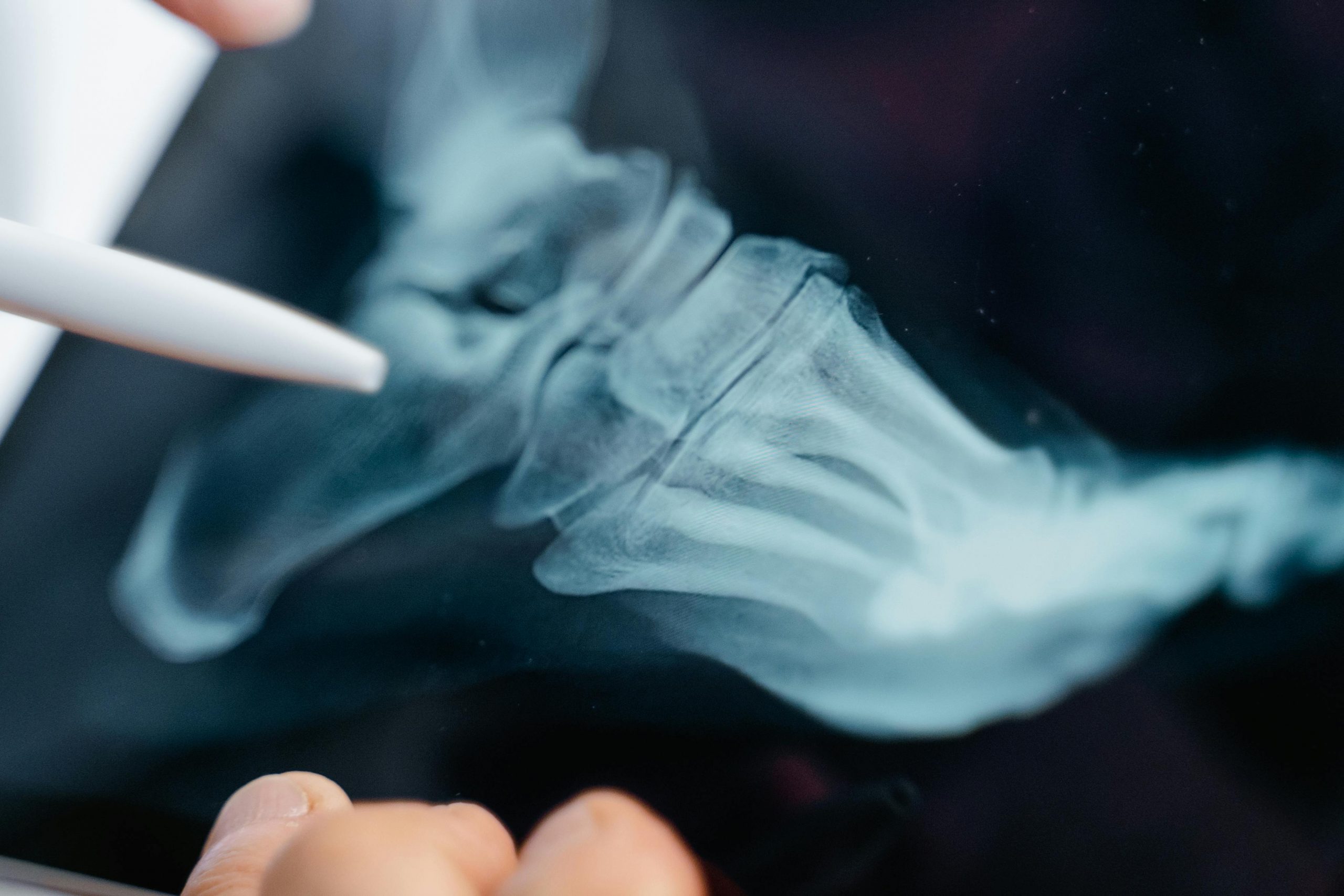Introduction
At Caledonia Foot Clinic, we believe that podiatry is not only about treating immediate foot problems but also about safeguarding wider health through early detection of systemic disease. This is particularly important in the rural communities we serve across the Highlands, where access to regular medical services can be limited. Many patients in these areas may not have frequent touch points with general practitioners or hospital specialists, which means that podiatry appointments often provide a rare opportunity for structured health screening.
One of the most effective ways we can contribute to this broader picture of health is through simple vascular assessments. The Royal College of Podiatry (RCPod) has consistently highlighted the importance of vascular screening as a core element of podiatric practice, recommending that Doppler ultrasound be used routinely to assess arterial flow and detect early signs of peripheral arterial disease (Royal College of Podiatry, 2025a). By embedding these assessments into our first appointments and annual reviews, we ensure that every patient, regardless of where they live, has access to the same high standard of care.
Annual foot checks are not just about monitoring localised issues such as skin integrity, nail health, or biomechanics. They are also an opportunity to identify systemic conditions that frequently manifest in the feet. Diabetes, cardiovascular disease, and peripheral arterial disease can all present with subtle changes in circulation or sensation, which may otherwise go unnoticed until they become advanced (Tehan et al., 2019). By using Doppler technology to listen to arterial waveforms, we can raise the alarm early, initiate timely referrals, and ultimately reduce the risk of serious complications such as ulceration or amputation.
For rural communities, this proactive approach is vital. A patient in a remote Highland village may not see their GP regularly, but they may attend a podiatry clinic for routine care. In these cases, podiatry becomes a frontline service for detecting systemic disease. At Caledonia Foot Clinic, we see this responsibility as central to our mission: to bridge the gap between community access and specialist care, ensuring that geography does not dictate health outcomes.
The Importance of Vascular Assessment in Podiatry
Vascular assessment is one of the most critical responsibilities within podiatric practice. The feet are uniquely vulnerable to circulatory compromise because of their distance from the heart and the relatively small calibre of the arteries that supply them. Even minor reductions in blood flow can have significant consequences, particularly when combined with other risk factors such as diabetes, smoking, or hypertension. For this reason, the Royal College of Podiatry (RCPod) has consistently emphasised that vascular assessment should be a routine part of podiatric care, not an optional extra (Royal College of Podiatry, 2025a).
Early detection of systemic disease
The feet often provide the first visible or measurable signs of systemic disease. Peripheral arterial disease (PAD), for example, may present with subtle symptoms such as cold toes, delayed capillary refill, or reduced pulses. Left undetected, PAD can progress to ulceration, infection, and in severe cases, amputation. Research has shown that podiatrists are often the first healthcare professionals to identify PAD, particularly in patients who do not regularly attend GP or hospital appointments (Tehan et al., 2019). By incorporating vascular assessment into every new patient consultation and annual review, podiatrists can act as an early warning system for wider health concerns.
The role of Doppler ultrasound
While palpation of pulses remains an important skill, it is not always reliable, especially in patients with oedema, obesity, or heavily calcified arteries. Doppler ultrasound provides an objective and reproducible method of assessing arterial flow. By listening to the quality of the waveform, podiatrists can distinguish between healthy triphasic signals and compromised monophasic signals, which may indicate arterial disease (Bailey Instruments, 2023). The RCPod has called for universal access to handheld Dopplers across all practice settings, including private practice, to ensure that every patient benefits from this standard of care (Royal College of Podiatry, 2025b).
Rural healthcare and equity of access
In rural communities, such as those served by Caledonia Foot Clinic, vascular assessment takes on an even greater importance. Patients living in remote areas may not have regular access to GPs, vascular specialists, or hospital clinics. For many, a podiatry appointment may be their only structured health check in a given year. By embedding vascular assessment into these visits, podiatrists can bridge the gap between community care and specialist services. This is particularly valuable in the Highlands, where travel distances and limited transport options can delay access to secondary care.
Preventing complications and reducing costs
The consequences of undiagnosed vascular disease are not only devastating for patients but also costly for the healthcare system. Amputations, prolonged wound care, and hospital admissions place a significant financial burden on the NHS. Studies have demonstrated that early detection and intervention can reduce the incidence of severe complications, improve quality of life, and lower long‑term healthcare costs (Tehan et al., 2019). By carrying out routine vascular assessments, podiatrists contribute directly to preventative healthcare, aligning with national priorities for early intervention and community‑based care.
Professional accountability and patient confidence
The RCPod’s professional standards make clear that podiatrists must be competent in vascular assessment and able to justify their clinical decisions (Royal College of Podiatry, 2025a). For patients, knowing that their podiatrist is trained and equipped to carry out these assessments builds confidence and trust. It also reinforces the role of podiatry as a medical profession that extends far beyond nail care, encompassing the detection and management of serious systemic disease.
What is a Doppler and How Does it Work?
A Doppler ultrasound is one of the simplest yet most powerful tools available to podiatrists. It is a small, handheld device that uses sound waves to assess blood flow in the arteries of the foot and ankle. Unlike more complex imaging techniques, the Doppler is quick, painless, and can be performed in any clinic setting, making it particularly valuable in community and rural practice.
The science behind the Doppler
The Doppler effect, first described in the nineteenth century, refers to the change in frequency of a sound wave when the source of that sound is moving relative to the observer. In medical practice, this principle is applied by directing high‑frequency ultrasound waves into the body. When these waves encounter moving red blood cells within an artery, they are reflected back at a slightly different frequency. The Doppler device translates this frequency shift into an audible signal that the clinician can interpret (Bailey Instruments, 2023).
What podiatrists listen for
When a podiatrist places the Doppler probe over the dorsalis pedis or posterior tibial artery, the device produces a characteristic sound that reflects the quality of blood flow.
- Triphasic signals are considered normal, indicating healthy, elastic arteries with good forward and reverse flow.
- Biphasic signals may still be within normal limits but can suggest some reduction in arterial elasticity.
- Monophasic signals are a warning sign, often associated with arterial narrowing or peripheral arterial disease (Royal College of Podiatry, 2025a).
This simple test provides immediate information about the state of circulation in the lower limb.
Combining Doppler with other assessments
The Doppler is often used alongside a sphygmomanometer to calculate the ankle‑brachial pressure index (ABPI). This involves comparing blood pressure at the ankle with blood pressure at the arm. An ABPI result below 0.9 is generally considered abnormal and may indicate peripheral arterial disease (Tehan et al., 2019). By combining waveform analysis with ABPI, podiatrists can build a more complete picture of vascular health.
Why it matters in podiatry
For patients, the Doppler test is quick, non‑invasive, and requires no preparation. Yet the information it provides can be life‑saving. Many systemic diseases, including diabetes and cardiovascular disease, affect the feet first. Reduced circulation can lead to delayed wound healing, ulceration, and infection. By using Doppler technology, podiatrists can detect these problems early and refer patients for further vascular assessment or intervention before complications develop (Royal College of Podiatry, 2025b).
Professional Standards and Guidance
The Royal College of Podiatry has issued position statements calling for universal access to handheld Dopplers and manual sphygmomanometers for all podiatrists, regardless of whether they work in the NHS or private practice (Royal College of Podiatry, 2025a). This reflects the College’s commitment to standardising care and ensuring that patients receive the same quality of vascular assessment across different settings.
Furthermore, the College’s professional standards emphasise that podiatrists must not only have access to Dopplers but also demonstrate competence in their use. This includes correct patient positioning, accurate interpretation of waveforms, and appropriate documentation of findings (Royal College of Podiatry, 2025b).
Clinical Applications
Doppler assessment is particularly important in the following contexts:
- Diabetic foot care: Early detection of PAD is critical in preventing ulceration and amputation.
- Wound management: Assessing perfusion helps determine healing potential and guides referral pathways.
- Pre‑surgical assessment: Ensures patients are suitable candidates for podiatric surgery.
- Routine annual reviews: As recommended by the RCPod, Doppler use should form part of annual foot reviews, even in asymptomatic patients, to detect subclinical disease (Royal College of Podiatry, 2025b).
Conclusion
Doppler ultrasound has become an indispensable tool in podiatric practice, not only for its technical ability to detect vascular compromise but also for the wider role it plays in preventative healthcare. The Royal College of Podiatry has made clear that vascular assessment, supported by Doppler use, is a professional expectation across all practice settings, including private clinics (Royal College of Podiatry, 2025a). This standardisation ensures that patients receive consistent, evidence‑based care regardless of geography or service model.
At Caledonia Foot Clinic, we see the Doppler as more than a diagnostic device. It is a bridge between community‑based podiatry and the wider healthcare system. In rural areas of the Highlands, where access to GPs and hospital specialists can be limited, podiatry often provides one of the few regular opportunities for structured health checks. By embedding Doppler assessment into every new consultation and annual review, we are able to identify early signs of systemic disease, raise concerns promptly, and ensure that patients are referred for further investigation when necessary. This proactive approach reduces the risk of serious complications such as ulceration, infection, and amputation, while also alleviating the long‑term burden on the NHS (Tehan et al., 2019).
The importance of this work extends beyond individual patient outcomes. Routine vascular assessment demonstrates the value of podiatry as a medical profession that contributes directly to public health. It reinforces the message that podiatrists are not only providers of routine foot care but also clinicians with a vital role in detecting and managing systemic disease. This dual responsibility is particularly significant in rural communities, where podiatry can act as a frontline service for early detection and intervention.
Looking ahead, the continued integration of Doppler technology into everyday podiatric practice will be essential. As the population ages and the prevalence of diabetes and cardiovascular disease increases, the demand for early detection of vascular compromise will only grow. By adhering to the standards set by the Royal College of Podiatry and ensuring equitable access to Doppler assessment across all settings, podiatrists can continue to protect patients, reduce health inequalities, and strengthen the role of community‑based care.
In summary, Doppler ultrasound is not simply a tool for listening to blood flow. It is a safeguard for patients, a marker of professional accountability, and a vital component of preventative healthcare. At Caledonia Foot Clinic, we are proud to bring this standard of care to the communities we serve, ensuring that geography does not dictate health outcomes and that every patient has the opportunity for early detection and timely intervention.
Bibliography
- Bailey Instruments (2023) The use of handheld Doppler ultrasound in podiatry and foot health. Available at: https://baileyinstruments.co.uk/blogs/news/the-use-of-handheld-doppler-ultrasound-in-podiatry-and-foot-health (Accessed: 3 November 2025).
- Royal College of Podiatry (2025a) The importance of access for all podiatrists to handheld Doppler and manual sphygmomanometers. Available at: https://rcpod.org.uk/the-college/position-statements/the-importance-of-access-for-all-podiatrists-to-handheld-doppler-and-manual-sphygmomanometers (Accessed: 3 November 2025).
- Royal College of Podiatry (2025b) The RCPod calls for universal access to handheld Doppler and manual sphygmomanometers. Available at: https://rcpod.org.uk/news/the-rcpod-calls-for-universal-access-to-handheld-doppler-and-manual-sphygmomanometers (Accessed: 3 November 2025).
- Tehan, P.E., Fox, M., Stewart, S., Matthews, S. and Chuter, V.H. (2019) ‘Lower limb vascular assessment techniques of podiatrists in the United Kingdom: a national survey’, Journal of Foot and Ankle Research, 12(31). Available at: https://jfootankleres.biomedcentral.com/articles/10.1186/s13047-019-0341-2 (Accessed: 3 November 2025).





